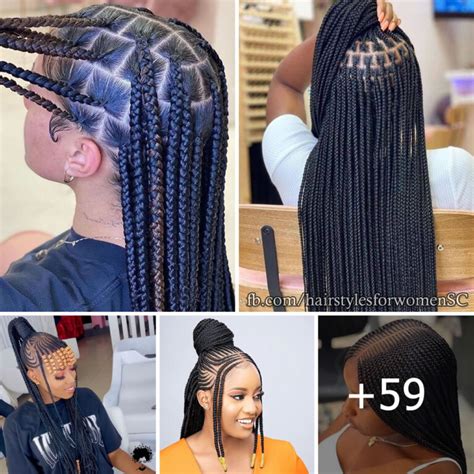Introduction
Braids, an intricate and versatile hair art form, have captivated women for centuries. From intricate crowns to elegant fishtails, braids offer endless possibilities to accentuate one’s beauty and express individuality. This comprehensive guide delves into the diverse world of 10,000 braids for women, providing step-by-step techniques, inspiring ideas, and practical tips to elevate your braiding game.

Types of Braids
1. Basic Braids
* Three-strand braid: The most fundamental and versatile braid, perfect for beginners.
* Dutch braid: A variation of the three-strand braid where the strands cross over instead of under.
* French braid: A variant of the Dutch braid that starts from the crown and gradually incorporates more hair as it progresses.
2. Intricate Braids
* Fishtail braid: A captivating braid that resembles the scales of a fish.
* Box braid: A protective style that involves dividing the hair into square sections and braiding them tightly.
* Cornrow braid: A popular braiding method originating from Africa, characterized by tightly braided rows that run along the scalp.
3. Decorative Braids
* Crown braid: A stunning braid that encircles the head like a tiara.
* Halo braid: A headband-like braid that adds volume and texture to hairstyles.
* French twist braid: A combination of a French braid and a twist, resulting in an elegant and voluminous updo.
Braiding Techniques
1. Sectioning and Preparation
* Divide hair into small, even sections to create a consistent braid.
* Brush out any tangles or knots to ensure smooth braiding.
2. Holding and Crossing
* Hold the three sections of hair firmly and cross the left strand over the middle strand.
* Bring the right strand over the middle strand and continue alternating.
3. Tightening and Finishing
* Pull the strands tightly to create a secure braid.
* Braid all the way to the ends of the hair and secure with an elastic band.
Braiding Ideas
1. Casual Braids
* Side braid: A simple yet stylish braid that can be worn to the side.
* Messy braid: A relaxed and effortless braid that adds texture and volume.
* Halo braid: A charming braid that creates a headband-like effect.
2. Formal Braids
* French twist braid: An intricate and elegant braid perfect for weddings and special occasions.
* Crown braid: A regal braid that adds a touch of royalty to any hairstyle.
* Fishtail braid: A unique and eye-catching braid that adds texture and depth.
Benefits of Braiding
- Styling versatility: Braids offer countless styling options, from casual to formal.
- Hair protection: Braids can help protect hair from breakage and damage, especially when used as protective styles.
- Time-saving: Braids can save time by reducing the need for daily styling.
- Hair growth: Braids can promote hair growth by reducing breakage and stimulating the scalp.
Importance of Braiding
- Cultural significance: Braids have played a significant role in various cultures throughout history.
- Expression of creativity: Braids allow women to express their individuality and style.
- Empowerment: Braids can empower women by connecting them to their cultural heritage and promoting self-expression.
Tips and Tricks
- Use hairspray: Apply hairspray to hold the braid in place and prevent flyaways.
- Incorporate hair accessories: Add beads, ribbons, or other accessories to embellish your braids.
- Experiment with different textures: Use extensions or curl your hair to add volume and interest to your braids.
- Accessorize: Use hair clips or headbands to complement and secure your braids.
FAQs
- What is the best type of hair for braiding? All hair types can be braided, but thicker hair tends to hold braids better.
- How often should I braid my hair? Braiding too often can cause hair damage. Limit braiding to 1-2 times per week.
- Can I braid my hair while it’s wet? Braiding wet hair can weaken it and cause breakage. Allow hair to dry first.
- How can I prevent my braids from getting loose? Use hairspray or gel to hold the braid in place.
- What is the difference between Dutch and French braids? Dutch braids are tighter and raised, while French braids are looser and more relaxed.
- How can I prevent scalp irritation from braiding? Use a scalp oil or serum to soothe irritation.
Conclusion
Braiding is an art form that celebrates creativity, beauty, and cultural expression. With endless possibilities for styling, protective styles, and personal expression, it’s no wonder braids have captivated women for generations. Embrace the versatility and beauty of braids and elevate your hair game to new heights.
Tables
| Braid Type | Technique | Difficulty |
|---|---|---|
| Three-strand braid | Crossing three sections of hair | Easy |
| Dutch braid | Crossing strands over instead of under | Moderate |
| French braid | Gradually incorporating more hair as it progresses | Moderate |
| Fishtail braid | Alternating sections of hair to resemble fish scales | Difficult |
| Special Occasion Braid | Styling | Suitability |
|---|---|---|
| French twist braid | Intricate and elegant | Weddings, special events |
| Crown braid | Regal and sophisticated | Formal occasions, proms |
| Halo braid | Headband-like, adds volume | Casual events, everyday wear |
| Braiding Benefit | Description |
|---|---|
| Styling versatility | Endless styling options for all occasions |
| Hair protection | Reduces breakage, promotes hair health |
| Time-saving | Minimizes daily styling time |
| Hair growth | Stimulates scalp, reduces hair loss |
| Braiding Tip | Purpose |
|---|---|
| Use hairspray | Hold braids in place, prevent flyaways |
| Experiment with textures | Add volume, interest to braids |
| Accessorize | Embellish braids, enhance style |
| Prevent scalp irritation | Use scalp oil to soothe irritation |
